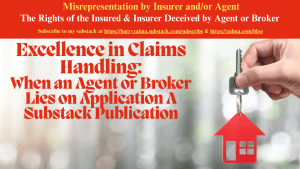Misrepresentation by Insurer and/or Agent

Insurance brokers, who represent the insured to transact insurance with, but not on behalf of, an insurer, often will try to make the process easy for the insured by filling out the application before asking the insured to sign it. It is a practice fraught with danger that can cause the insured to have no coverage at all and make the broker a defendant in a major lawsuit.
For example, in Douglas v. Fidelity National Insurance Co., 229 Cal.App.4th 392, 177 Cal.Rptr.3d 271, 14 Cal. Daily Op. Serv. 10,315, 2014 Daily Journal D.A.R. 12,127 (2014) the insureds sued a fire insurer for bad faith. The Superior Court, Alameda County, entered judgment on special jury verdict awarding damages to the insureds, but struck the jury’s $1.9 million punitive damages award following the granting, in part, of insurer’s motion for judgment notwithstanding the verdict (JNOV). The insurer appealed.
In December 2010, plaintiffs went to a business called Cost–U–Less Insurance (Cost–U–Less) where, over the telephone, an InsZone Insurance Services (InsZone) employee assisted them in obtaining a homeowner’s insurance policy with Fidelity. Three months later a fire damaged plaintiffs’ home.
After an investigation, Fidelity rescinded the homeowner’s policy on the grounds that plaintiffs’ insurance application contained material misrepresentations about various facts concerning plaintiffs’ and their home. Fidelity stated it would not have issued the policy had it known the truth about the misrepresentations.
In December 2010, plaintiffs went to a Cost–U–Less store in Stockton to purchase an insurance policy for the Locust Street home. The insurance paperwork signed consisted of three pages. The first page was a blank form. The employee at Cost–U–Less did not ask him any questions about the property. Jerry signed the documents and gave the employee a check.
After the fire and investigation by Fidelity, Jerry received a letter dated May 31, 2011 from an attorney named Jeffrey Charlston. The letter included a check from Fidelity in the amount of the insurance premium Jerry had paid. Charlston stated that in the course of investigating the fire loss, evidence had developed showing material misrepresentations had been made in connection with plaintiffs’ insurance application.
The alleged misrepresentations pertained to:
1) whether any unit in the structure was occupied by more than one family,
2) whether the electrical panel utilized circuit breakers or fuses,
3) whether there were roommates or boarders in the home and/or if the home was used as a rooming or boarding house, and
4) whether a business was conducted on the property.
Charlston also stated it did not appear Jerry had ever personally lived in the home, asserting the property was being used either as a halfway house for parolees or as a rehab facility. Jerry testified that these claims were untrue. Finally, Charlston advised that plaintiffs owed Fidelity in excess of $24,000 for benefits already paid.
Richard Gasparini, Jr., had visited On the Right Path several times. During one such visit, he was setting up his laptop computer when people came through the front door yelling that they had a search warrant. He was handcuffed and taken out to the street. In connection with that visit he created a report dated December 30, 2009. He also visited plaintiffs’ home on February 10, 2011. Later, Betty came to his office and told him about the fire. She said several times that she wanted to relocate the facility to another house.
Bruce LeBlanc evaluates policies to ensure they meet Fidelity’s underwriting guidelines. He confirmed that insurance brokers use Fidelity’s website to complete online applications. The application program is called Fidelity Rating and Internet Service Technology (F.I.R.S.T.).
It automatically quotes and underwrites policies in real-time. Some of the questions on the application are underwriting questions and others are rating questions. The rating questions pertain to the quote for the premium on a specific policy. The underwriting questions are intended to qualify the risk for acceptance. The broker obtains the relevant information from the applicant and inputs it into the F.I.R.S.T. system. Once the application is submitted, the broker can print the signature page off the Internet and have the applicant sign it. The system will not approve applications that have unacceptable underwriting responses.
It is well established in California that material misrepresentations or concealment of material facts in an application for insurance entitle an insurer to rescind an insurance policy, even if the misrepresentations are not intentionally made. To prevail, the insurer must prove that the insured made a material “false representation” in an insurance application.
The evidence presented at trial would support a finding that plaintiffs were licensed to operate a residential care facility out of their home and that they received money in exchange for providing room and board to mentally ill clients. For example, the unusual incident/injury report that Betty submitted to the licensing agency after the fire states that two male clients were residing in the home at the time of the fire. Plaintiffs’ counsel essentially stipulated, outside the presence of the jury, that Betty was running a business out of her home.
This article was adapted from my book Zalma on Insurance Claims Part 103 Third Edition Available as a paperback and Available as a Kindle Book
Like this:
Loading…



